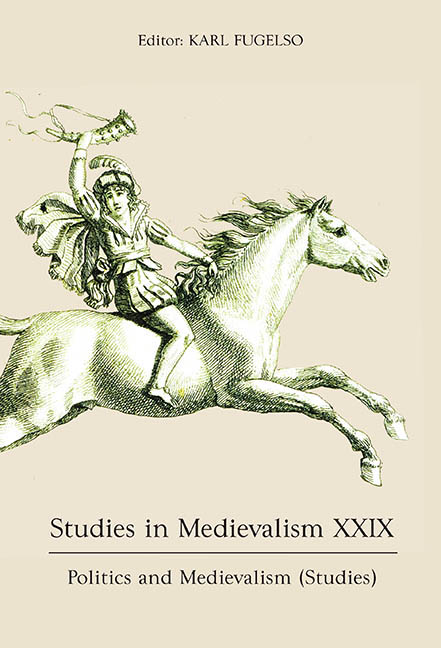Book contents
- Frontmatter
- Studies in Medievalism
- Acknowledgments
- Contents
- List of Illustrations
- Preface
- I Essays on Politics and Medievalism (Studies)
- Historical Malapropism and the Medieval Blood Libel in American Politics
- Putin’s Medieval Weapons in the War against Ukraine
- The Battle of Tours and the US Southern Border
- Medievalism, Brexit, and the Myth of Nations
- An Arthur for the Brexit Era: Joe Cornish’s The Kid Who Would be King
- II Other Responses to Medievalism
- Angle-ing for Arthur: Erasing the Welsh in Guy Ritchie’s King Arthur: Legend of the Sword
- Chasing Freyja: Rape, Immigration, and the Medieval in Alt-Right Discourse
- “Things painted on the coarse canvas”: Political Polemic in Jean-Paul Laurens’s Portrait of the Child Emperor Honorius
- Longfellow and Old English
- Archaeology and Medievalism at Julian of Norwich’s Anchorite Cell
- A Revelation of Love: Christianity, Julian of Norwich, and Medieval Pity in the Harry Potter Series
- In the Beginning Was the Word: How Medieval Text Became Fantasy Maps
- Objectivity, Impossibility, and Laughter in Doctor Who’s “Robot of Sherwood”
- Sonic Medievalism, World Building, and Cultural Identity in Fantasy Video Games
- Contributors
- Miscellaneous Endmatter
“Things painted on the coarse canvas”: Political Polemic in Jean-Paul Laurens’s Portrait of the Child Emperor Honorius
Published online by Cambridge University Press: 19 August 2020
- Frontmatter
- Studies in Medievalism
- Acknowledgments
- Contents
- List of Illustrations
- Preface
- I Essays on Politics and Medievalism (Studies)
- Historical Malapropism and the Medieval Blood Libel in American Politics
- Putin’s Medieval Weapons in the War against Ukraine
- The Battle of Tours and the US Southern Border
- Medievalism, Brexit, and the Myth of Nations
- An Arthur for the Brexit Era: Joe Cornish’s The Kid Who Would be King
- II Other Responses to Medievalism
- Angle-ing for Arthur: Erasing the Welsh in Guy Ritchie’s King Arthur: Legend of the Sword
- Chasing Freyja: Rape, Immigration, and the Medieval in Alt-Right Discourse
- “Things painted on the coarse canvas”: Political Polemic in Jean-Paul Laurens’s Portrait of the Child Emperor Honorius
- Longfellow and Old English
- Archaeology and Medievalism at Julian of Norwich’s Anchorite Cell
- A Revelation of Love: Christianity, Julian of Norwich, and Medieval Pity in the Harry Potter Series
- In the Beginning Was the Word: How Medieval Text Became Fantasy Maps
- Objectivity, Impossibility, and Laughter in Doctor Who’s “Robot of Sherwood”
- Sonic Medievalism, World Building, and Cultural Identity in Fantasy Video Games
- Contributors
- Miscellaneous Endmatter
Summary
In his paintings of medieval historical subjects, the French academic painter Jean-Paul Laurens (1838–1921) often portrayed abusive clerics and corrupt rulers. For Laurens, a stalwart republican and secularist, medieval history offered evidence of the past malfeasance of church and crown. With his 1880 painting Lower Empire: Honorius (Fig. 1), which depicts the fifth-century child emperor on his coronation day, Laurens explored the problem of hereditary kingship, which could allow an accident of birth to elevate an inept ruler to the throne.
In the painting, Laurens addressed not only the problems associated with monarchical political systems, but more specifically the failings of the French emperor Napoleon III, who reigned from 1852 until 1870. With the portrait of the ancient ruler, Laurens implicated the modern one by referencing Jean- Auguste-Dominique Ingres's depiction of Napoleon I (Fig. 2). Laurens's coronation portrait is a visual antithesis to Ingres's painting. Using Honorius as a stand-in for Napoleon III, he reveals the problem of assuming the heir of a great leader would himself excel. Laurens's painting further elaborates on the idea by alluding to Victor Hugo's treatise Napoleon le petit, an 1852 publication that denounced the latter French emperor. In this chapter, I shall show how Laurens's painting of Honorius is an allusion to Napoleon III and is meant to celebrate his downfall and the subsequent establishment of the democratic Third Republic.
Lower Empire: Honorius is a perfect representation of the predicament of hereditary monarchy. The ten-year-old boy came to the throne in 393CE, after his father Theodosius had made him ruler of the western half of the empire and his seventeen-year-old brother Arcadius ruler of the eastern half. Honorius reigned for thirty years from his capital in Ravenna, but never did grow into the role of emperor. Instead, he was notoriously incompetent and mainly remembered for allowing the collapse of the Western Roman Empire. His failed rule was characterized by the eighteenth-century historian Edward Gibbon in his Decline and Fall of the Roman Empire in this scathing fashion:
The son of Theodosius passed the slumber of his life a captive in his palace, a stranger in his country, and the patient, almost indifferent, spectator of the ruin of the Western Empire, which was repeatedly attacked and finally subverted by the arms of the barbarians.
- Type
- Chapter
- Information
- Studies in Medievalism XXIXPolitics and Medievalism (Studies), pp. 83 - 98Publisher: Boydell & BrewerPrint publication year: 2020



